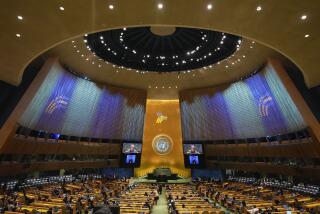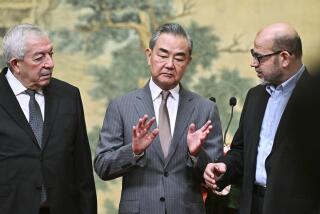Plan for Unified Bosnia Is OKd--but Not Truce
- Share via
UNITED NATIONS — Leaders of Bosnia’s warring factions agreed Tuesday to establish the legal trappings of a unified government, but the top American mediator conceded that the plan is still “too vague” to bring the bloody ethnic war to an end.
After a day of cliffhanging negotiations that constantly threatened to break down, the factional leaders decided to create a collective presidency, a federal Parliament and a constitutional court for all of Bosnia-Herzegovina, even though they had agreed previously that control of almost half of Bosnian territory would be ceded to the rebel Serbs.
U.S. peace envoy Richard Holbrooke said the plan fills in some of the gaps left in the earlier agreement, reached last month in Geneva, but he freely admitted that many points were intentionally left ambiguous. “It isn’t strong enough yet,” he said.
In Washington, President Clinton hailed the result as a step toward ending a conflict that has bedeviled his presidency.
“Today’s agreement moves us closer to the ultimate goal of a genuine peace, and it makes clear that Bosnia will remain a single internationally recognized state,” the President said.
Holbrooke expressed hope that the agreement will clear the way for the start of a formal Bosnia peace conference. But he admitted that the warring factions rejected mediators’ call for a cease-fire.
A senior U.S. official said later that an end to the hostilities is desirable but would not be a precondition for opening a peace conference. He noted that both the Korean War and the Vietnam War dragged on for years after the start of peace talks.
“We don’t like ‘fight and talk,’ but that’s what they are going to do,” the official said.
Holbrooke and European Union mediator Carl Bildt plan a series of separate meetings with the factional leaders today. Holbrooke and his U.S. peace team will return to the Balkans on Thursday to continue the talks.
Tuesday’s agreement by the foreign ministers of the Muslim-led but secular Bosnian government, Croatia and the rump Yugoslavia--which is representing the Bosnian Serbs--would create a loose federal government strikingly like the one that Yugoslav leader Josip Tito left in place at the time of his death in 1980.
Although the old Yugoslav federal government was widely considered to be weak and unwieldy, a senior U.S. official said the parties to the Bosnian conflict were comfortable with that structure.
The new, overarching government of Bosnia would be led by a collective presidency in which the present Bosnian government and its Croatian allies would hold two-thirds of the seats and the rebel Serbs would hold one-third. However, the negotiators were unable to decide whether the presidency should consist of three, six, nine or some other multiple of three members.
They also agreed to establish a Parliament with the same two-thirds/one-third split between the Muslim-Croat federation and the Serbs.
Although the formula seems to give a clear majority to the Muslim-Croat federation, the agreement contains complex voting procedures that seem to require the agreement of both communities on most important matters. For instance, most decisions of the presidency could be blocked by one-third of the members. In the Parliament, action could be blocked by a two-thirds vote of members representing either entity.
In response to a demand by the present Bosnian government, all officers would have to be chosen by free and fair elections.
The agreement gives the new federal government authority over Bosnia’s foreign policy and assigns to it Bosnia’s seat in the United Nations. But the factions were unable to agree on the division of other governmental functions between the federal regime and the governments of the separate Muslim-Croat and Serbian entities.
Moreover, the Tuesday meeting failed to settle the most difficult and emotional issue--allocation of territory between the Muslim-Croat federation and the Serbs.
The factions agreed in Geneva to a split that would give the federation 51% of the territory and the Serbs 49%. And, as a result of this month’s Muslim-Croat offensive, the military confrontation lines now reflect almost exactly a 51-49 split, a dramatic change from the past three years when the Serbs controlled about 70% of the country.
But U.S. officials said no side is ready to accept the present map as the final one.
Although the agreement is designed to prevent the Serbs from pulling out of the new Bosnian structure and annexing themselves to neighboring Serbia, U.S. officials admit there are no real guarantees.
“Our greatest nightmare is that we will get this agreement [completed] and then the Serbs will be annexed to Serbia,” Holbrooke said. “Does this agreement prevent that? Not yet.”
The agreement also does nothing to prevent the Bosnian Serbs from voting into office leaders such as Radovan Karadzic and Gen. Ratko Mladic, both of whom have been indicted by an international tribunal in The Hague for war crimes.
Bosnian Foreign Minister Muhamed Sacirbey, taking time away from the meeting to deliver Bosnia’s speech to the opening session of the U.N. General Assembly, complained that his government had been warned, presumably by U.S. mediators, “that the negotiating process would collapse if we persist in demanding that the extradition demands of the internationally mandated war crimes tribunal in The Hague must be honored by all authorities within a future Bosnia and Herzegovina, consistent with international law.”
Later, Sacirbey told a news conference: “It’s either a free and democratic Bosnia and Herzegovina with Karadzic and Mladic in The Hague, or it’s a continuation of what we have now.”
Nevertheless, Sacirbey said his government is willing to work within the structure outlined by Tuesday’s agreement.
* U.S. DEPLOYMENT: Congress is said to be unlikely to keep troops from Bosnia. A10
More to Read
Sign up for Essential California
The most important California stories and recommendations in your inbox every morning.
You may occasionally receive promotional content from the Los Angeles Times.













